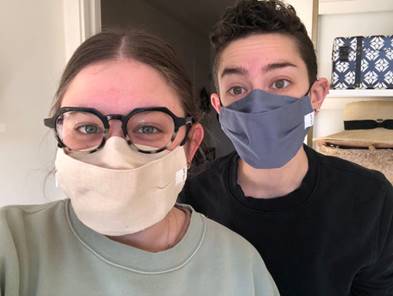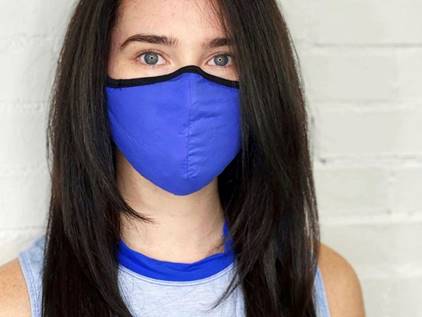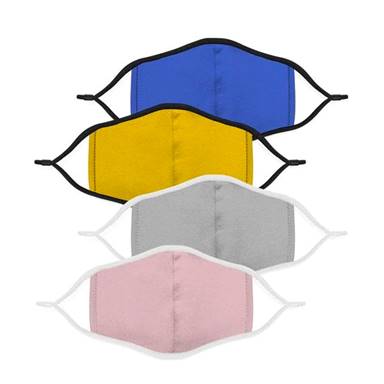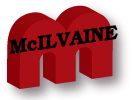
CATER Mask
Decisions
January 18, 2021
Mask Webinar on Thursday will be Part of a
Decision Guide for Immediate Action on Effective
Masks
Mask Regulation Challenge Similar to That for
Automobile
Safety
but in Weeks not Decades
Media Supply Capabilities
Sufficient Essential Braces can be Supplied to
Meet Needs
Jabil is Capable of Producing Large Numbers of
Masks
Quick Fit Testing Methods are Needed- How About
Thermal Imaging?
Some Thermal Imagers Already Recognize Face
Masks
How About the Temperature Scanners Presently
Being Used
Thermal Imaging of Mask Leakage During
Pressure-Controlled Ventilation (BIPAP Therapy)
Measurement of Facial Temperatures is Another
Approach
Evaluation of Popular Masks
______________________________________________________________________________
Mask Webinar on Thursday will be Part of a
Decision Guide for Immediate Action on Effective
Masks
Many important decisions need to be made about
masks now not weeks or months from now. There is
now consensus that more effective masks are
needed.
Thousands of people wearing inefficient cloth
masks will die each week because they did not
know the importance of wearing effective masks
and were not provided with a guide for
purchasing them.
The ASTM standard will be an important element
of a guide.
But it is not scheduled to be published
until sometime in February and it is unclear
when labels will start appearing on masks.
Action can be taken immediately to educate the
public and supply them with effective masks.
The webinar on Thursday will bring
together people with the insights and capability
to accelerate this initiative.
We invite you to join us at 10:AM CST on
Thursday, January 21 and also to make relevant
comments or ask questions. You can register at
http://www.mcilvainecompany.com/CATER/subscriber/default.htm
Mask Regulation Challenge Similar to That for
Automobile Safety but in Weeks not Decades
Masks are just as much of a necessity as are
cars.
We would like our cars to be as
comfortable and attractive as possible. But can
you imagine a regulatory environment such as in
1915 with no stop signs, drivers licenses or
concerns about safe designs. The death rate in
1915 per passenger mile would be the equivalent
of millions of deaths per year today.
The mask initiative is equivalent to the modern
auto industry without safety standards or any
road safety regulations.
The 1915 advertisements for this slick looking
automobile are similar to the ones for most
masks sold today.
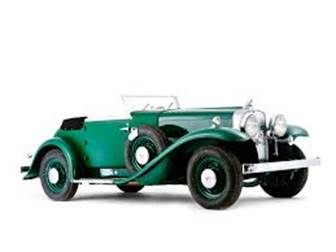
Today there are rigid requirements including
seat belts and licenses. No one is arguing that
these protective measures are not required.
There will be a similar evolution in mask
wearing except that it has to happen in weeks
not decades.
In 1923, the first year miles driven was
estimated, the motor-vehicle death rate was
18.65 deaths for every 100 million miles driven.
Since 1923, the mileage death rate has decreased
93% and now stands at 1.22 deaths per 100
million miles driven.
U.S. death rates are around 36,000 per year. If
we had maintained the 1923 safety standard there
would be three million deaths per year. Would
anyone argue that the standards were not
necessary?
The COVID death toll has risen to a level which
is 20 times higher than the auto death rate.
This justifies standards which have the same
impact on deaths as auto standards.
The FFE 90 mask is equivalent to the present
1.22 deaths per 100 million miles while the ASTM
50 is closer to the 18.65 deaths per 100 million
miles. The cloth masks are closer to the rate
for motorcyclists.

Media Supply Capabilities
Gearing up to meet any mask demand is a function
of media availability and not mask machines or
production lines. Mask makers have shown the
capability to build lines within weeks.
However, it can take six months to build
a meltblown line making spunbond, meltblown,
spunbond laminates.
A ton of meltblowns will make 350,000 N95 masks
or 1 million surgical masks. Here is a chart
from our Alert a few months ago showing Chinese
face mask production at 150 tons per day.
|
Meltblown Production in tons per day |
|||
|
Sector |
Total |
Face Mask |
Filter and Other |
|
U.S. April 15 up 23% (but maybe only face mask) |
750? |
10 |
741? |
|
U. S Jan 1 |
680 |
2 |
675 |
|
3M April 1 2020 (includes U.S. import) |
|
15 |
|
|
3M June 1 U.S. only |
|
5 |
|
|
China and Taiwan Mask Import to U.S. Jan 1 80% including 3M |
|
5 |
|
|
China Jan 1 |
146 |
30 |
|
|
China Government Controlled Jan 1 |
42 |
42? |
|
|
Sinopec April 1 |
18 |
18 |
|
|
China April 1 |
300 |
150 |
|
|
China Government Controlled Including Sinopec April 1 |
75 |
75? |
|
So this is some combination of up to 52.5
million N95 masks or 150 million surgical masks
per day. If there are 100 million surgical masks
per day then yearly production is 36.5 billion.
Most U.S. meltblown production is still for
products other than masks. The U.S. has ramped
up production but it still is a fraction of the
Chinese production. World production may be 50
billion meltblown masks per year or 6.2
masks for every person on earth.
If each person wore a surgical mask for two
months the present capacity would be sufficient.
If the surgical mask with an essential brace can
provide FFE 90 efficiency with limited use, what
will be the efficiency after 60 days. Let’s use
the comparative chart for various efficiencies
as a reference point. Would efficiency be
reduced to the ASTM 50 level or to that of cloth
masks?

Most surgical masks are replaced due to
contamination. We pointed out in an Alert last
week that a nurse in a COVID unit would be
exposed to the same viral load in an hour as
would the average office worker in 100 days in a
non-peak pandemic period. Blood splashes are
also unlikely. Masks can be rotated instead of
spray, H2O2, or UV cleaning which also extends
life.
Nanofibers can be sufficiently efficient to meet
the ASTM 50 requirements and certainly the ASTM
20. This media is more easily cleaned and is
widely available.
The conclusion is that everyone can be protected
very quickly. This can probably be at the FFE 90
level but if not at the ASTM 50 level which
would represent an 85% virus reduction.
Sufficient Essential Braces can be Supplied to
Meet Needs
Sabrina Paseman, CEO of Fix The Mask has
provided additional information on the essential
brace. “Our most relevant video will be this
one: https://youtu.be/Vd_5yU5uobA”
A sample scaling plan is below. Both LSR and
compression molding are viable manufacturing
processes to manufacture this product, and many
vendors have this capability. Below is the
potential if we bring up just eight additional
such vendors.

Since these braces are reusable it is possible
to meet the demand. At three million mask braces
close to 1% of the U.S. population could be
supplied with masks each week just with the
present vendors. Given the ease of manufacture
this rate can be quickly expanded to meet
whatever demand is needed.
Jabil is Capable of Producing Large Numbers of
Masks
Jabil says “ we strive to make ANYTHING POSSIBLE
and EVERYTHING BETTER. With over 260,000
diverse, talented, and dedicated employees
across 100 locations in 30 countries, our vision
is to be the most technologically advanced and
trusted manufacturing solutions provider. We
combine an unmatched breadth and depth of
end-market experience, technical and design
capabilities, manufacturing know-how, supply
chain insights and global product management
expertise to enable success for the world’s
leading brands. We are driven by a common
purpose to make a positive impact for each
other, our communities, and the environment.
“As of September 2020, about 90% of PPE in the
U.S. Strategic National Stockpile had already
been distributed to state and local governments.
And it’s estimated that 129 billion (with a B!)
disposable face masks are being used every month
around the world. (This number has popped up
in various articles. But if true represents 16
masks per person or one every two days.
McIlvaine estimates a lower number. McIlvaine
estimates an average of 0.6 surgical masks per
person per month. Most cheap cloth masks are
reused.)
To respond to this need for our own Jabil
employees and the communities where we operate,
Jabil and our medical device subsidiary, NP
Medical, have been manufacturing high
performance face masks at several facilities.
Applying our expertise, automation, and
dedication to quality, we have the capacity to
make and ship millions of masks each month.
In the U.S., Jabil has launched a substantial
face mask manufacturing operation to address the
demand for face masks and other PPE. There is an
eagerness and urgency within the country to
support re-opening in parallel with the benefits
forthcoming from effective vaccination programs.
Jabil factories in Memphis, Tennessee and
Gurnee, Illinois are producing masks – an
operation which will scale to a target of 1.6
million single-use face masks per day. Jabil’s
scale and expertise provides a path forward and,
if needed, can ramp up to manufacturing over two
billion face masks per year.
In highest use among frontline medical workers
are the disposable blue face masks or surgical
masks. The NP Medical nPro™ surgical masks are
designed to protect both patients and healthcare
worker from the transfer of microorganisms,
blood and body fluids and airborne
particulates. They are 3-ply disposable masks
with comfortable, adjustable elastic ear loops.
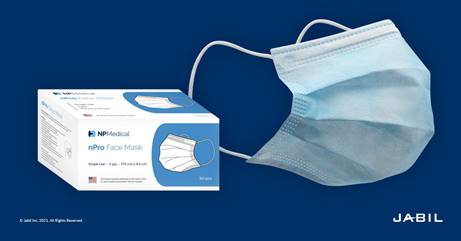
Quick Fit Testing Methods are Needed- How About
Thermal Imaging?
Last week we proposed inserting LED lights
inside masks to check fit. This week we looked
at thermal imaging after a recommendation from
Erick Couch and were surprised to learn that it
already has been evaluated and recommended for
use in airports as well as medical clinics.
For those of you who subscribe to Coronavirus
Technology Solutions we have been covering
thermal imaging for temperature detection. One
major supplier is FLiR.
Sorted by relevance / Sort
by date
1. McIlvaine
Coronavirus Market Alert
... twice
in the two weeks since he installed the cameras,
which are made by FLiR,
a company that specializes in thermal imaging
cameras. There has been a dramatic ...
Terms matched: 1 - Score: 18 - 29
Apr 2020 - URL:
http://www.mcilvainecompany.com/coronavirus/subscriber/Alerts/2020-04-22/Alert_20200422.html
The research relative to mask leakage is
analyzed in a decade
old paper “Thermal Image Analysis for
Detecting Facemask Leakage Jonathan Dowdall,
Ioannis Pavlidis, and James Levine Department of
Computer Science, University of Houston, 501
Philip G. Hoffman Hall, Houston, TX 77204-3010 #
Division of Endocrinology Department of Internal
Medicine Endocrine Research Unit Mayo Clinic,
Rochester MN 5590.
Approved facemasks are typically effective
physical barriers for preventing the spread of
viruses through droplets, but breaches in a
mask’s integrity can lead to an elevated risk of
exposure and subsequent infection. Quality
control mechanisms in place during the
manufacturing process insure that masks are
defect free when leaving the factory, but there
remains little to detect damage caused by
transportation or during usage. A system that
could monitor masks in real-time while they were
in use would facilitate a more secure
environment for treatment and screening. To
fulfill this necessity, we have devised a
touchless method to detect mask breaches in
real-time by utilizing the emissive properties
of the mask in the thermal infrared spectrum.
Specifically, we use a specialized thermal
imaging system to detect minute air leakage in
masks based on the principles of heat transfer
and thermodynamics. The advantage of this
passive modality is that thermal imaging does
not require contact with the subject and can
provide instant visualization and analysis.
These capabilities can prove invaluable for
protecting personnel in scenarios with elevated
levels of transmission risk such as hospital
clinics, border check points, and airports.
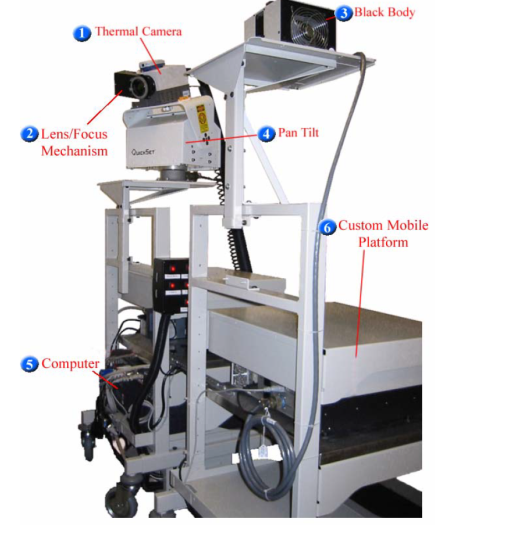
1.
A Phoenix InSb 320x256 Mid-Wave IR (MWIR) Camera
with Real Time Imaging Electronics (RTIE). The
Phoenix Camera Head has a 320x256 Indium
Antimonite (InSb) sensor on ISC9803 readout
integrated circuit, which is sensitive in the
3-5 μm waveband. The RTIE provides 14-bit
digital output at 12.2 MHz, with a maximum full
window frame rate of 60Hz. The camera features
temperature sensitivity of 0.010 C.
2.
A Mid-Wave IR (MWIR) 50mm Lens, f/2.3, Si:Ge,
bayonet mount; It features a motorized focusing
mechanism with RS-232 interface.
3.
A Santa Barbara Infrared model 2004, 4”
Differential Blackbody (-150 C to 350 C delta T)
with RS-232 interface. It features temperature
sensitivity of 0.010 C, which matches the
temperature sensitivity of the camera.
4.
A Quickset Pan Tilt Head (model QPT-90/1301C)
150 lb capacity. Pan 4350 , 80 /sec. Tilt ±900 ,
30 /sec. It features RS-232 interface.
5.
A consumer level computer.
6.
A custom
mobile platform.
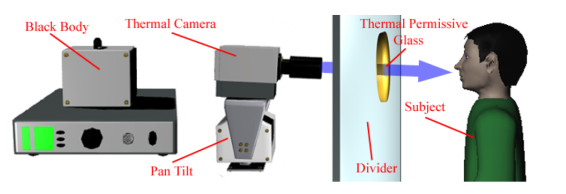
From the raw thermal imagery, facial features
are identified and the facial contour is
defined. An algorithmic process separates the
breath from the background by subtracting the
exhalation image from a reference image of the
subject taken during inhalation. This
differencing operation enhances the contrast
between breath and the rest of the background
(see Fig. 5(b)). Thermal currents emanating from
the facial contour are then recognized and from
these images any physical breach of the mask is
easily identified (Fig. 5(e)). A novel algorithm
that compresses non-linearly selected portions
of the color map range aids the visualization by
highlighting the air-leakage (Fig. 5(f)). Fig.
5. i

We have developed a system and a method for
detecting minute air leakage in face masks. The
approach is based on principles of heat transfer
and thermodynamics and has been implemented
using a specialized thermal imaging system. We
have experimented successfully with seven
different subjects wearing intact and punctured
masks at frontal and side views. The advantage
of this approach is that thermal imaging does
not require contact with the subject and can
provide instant visualization and analysis.
Therefore, cameras could be placed remotely in
hospital clinics, at border controls, or in
airports.
http://www.cpl.uh.edu/publication_files/I5.pdf
How About the Temperature Scanners Presently
Being Used
Many facilities use temperature scanners to
determine whether someone is sick. Could they be
used to detect leaks? Here is
a portable one for less than $7,000 from
Artemis.
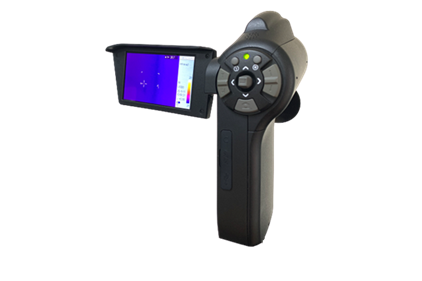
Some Thermal Imagers Already Recognize Face
Masks
DeskFlex thermal scanner and mask detection
system also comes with an interactive TV screen.
The interactive TV screen displays information
on whether the individual can proceed to enter
or not. DeskFlex can detect elevated body
temperature and uncovered faces. When any of the
criteria is missing, DeskFlex denies him/her of
entry. Moreover, it screens people using a
camera sensor allowing a contactless user
authentication.
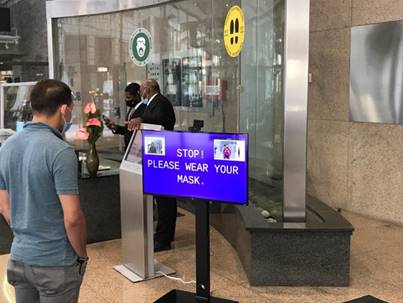
Thermal Imaging of Mask Leakage During
Pressure-Controlled Ventilation (BIPAP Therapy)
Ventilatory masks are crucial for the quality of
ventilation as well as for the acceptance of
therapy. While a comfortable fit is important
for acceptance, air-tightness of the mask will
determine the quality of ventilation. As leakage
quantification of BIPAP therapy has already been
established, we are now introducing a method to
localize such leakage.
Methods: Ventilatory masks that are not airtight
will have a high flow air current in between the
face mask and the facial skin. This current will
result in a drop in temperature of the skin
surface already after a few minutes in the
leaking area. Thermography (NEC TH 71 thermal
imager) can localize these skin areas and thus
the corresponding areas of the mask.
Results: Existing leakages were detected in
every case. The regional decrease in skin
temperature turned out to be 3–5°C. In the case
of individual masks, the leaking part of the
mask was clearly detected for further revision
by the dental technician. Refinement of the mask
resulted in satisfactory air-tightness and good
quality of ventilation.
Discussion: While instituting BIPAP therapy
thermographic leak imaging appears to be an
efficacious method that enlarges the
methodological inventory for leakage evaluation.
Especially for the manufacturer of individual
masks, exact leak detection will result in a
successful solution for the patient, the
physician, and the dental technician. The
disadvantages of this method are that it is
quite costly and that deficient consideration
was given that different body positions might
have a variable impact on leakage.
https://link.springer.com/article/10.1111%2Fj.1439-054X.2004.00022.x
Measurement of Facial Temperatures is Another
Approach
Individual respiratory protective devices and
face masks represent critical tools in
protecting health care workers in hospitals and
clinics and play a central role in decreasing
the spread of the high-risk pandemic infection
of 2019, coronavirus disease (COVID-19). The aim
of the present study was to compare the facial
skin temperature and the heat flow when wearing
medical surgical masks to the same factors when
wearing N95 respirators. A total of 20 subjects
were recruited and during the evaluation, each
subject was invited to wear a surgical mask or
respirator for one hour. The next day in the
morning at the same hour, the same subject wore
a N95 mask for one hour with the same protocol.
Infrared thermal evaluation was performed to
measure the facial temperature of the perioral
region and the perception ratings related to the
humidity, heat, breathing difficulty, and
discomfort were recorded. A significant
difference in heat flow and perioral region
temperature was recorded between the surgical
mask and the N95 respirator (p < 0.05).
A statistically significant difference in
humidity, heat, breathing difficulty, and
discomfort was present between the groups. The
study results suggest that N95 respirators are
able to induce an increased facial skin
temperature, greater discomfort and lower
wearing adherence when compared to the medical
surgical masks.
The McIlvaine takeaway from this is that while
the study focused on discomfort as a function
of skin temperature the big variable is
leakage. So the approach might be quite valid
for determining mask fit.
https://www.ncbi.nlm.nih.gov/pmc/articles/PMC7369838/
Evaluation of Popular Masks.
Insider
has been rating popular masks. Criteria are
absent filter efficiency and fit estimates .
McIlvaine has added some additional
information. Twenty-two masks are included in
the analysis. We are including two here and will
cover the others in later Alerts.
Graf Lantz Zenbu Face Mask
A couple of us on the Insider team
decided to test these Graf Lantz masks after we
kept seeing ads for them on social media. We
spent most of the pandemic convinced that Vida's
masks were the absolute best you could buy, but
these ones are even better. The nose bridge is
made from a thick, flexible strip rather than a
wire, so you get a better fit and no glasses fog
or rogue wires poking through the fabric. The
elastic ear bands are also adjustable, and the
mask is made from multiple layers of material to
adhere to CDC guidance. The construction is such
that you have more breathing room, and the mask
doesn't feel suffocating in the least. It also
has room for filters.
They come in two sizes, regular and petite, and
a cotton or linen finish. My partner and I got a
couple of each size and material, and we
recommend that most people get the petite size.
The regular size is really more for people with
large heads or faces (it's probably especially
great for people with beards). — Sally
Kaplan, senior editor
McIlvaine Comments:
·
The pack of 10 replacement filters sells for
$12.
·
Filter size measures 4.8 x 3.15 inches /12 x 8
cm
·
Fits inside the Zenbu Regular and Petite, Anshin
and Shinyu mask filter pocket.
·
Made of activated carbon and non-woven
melt-blown filter cloth protecting from a range
of airborne contaminants.
-
5 layer system to filter dust
and airborne particles.
-
Can be placed inside the folds
of the Anshin Face Mask to
additionally protect against
contamination.
-
These filters are disposable,
cannot be washed and should be
replaced every 1-4
days depending on amount of use.
-
Packaged in sets of 2 filters. 5
packs of 2 filters per order.
Since meltblowns are used the filter could be
efficient. There is no precise fit information
although they cite the thick flexible strip nose
bridge as providing a tight fit.
Protective Mask from Vida
Mara Leighton/Business Insider
“I've really loved these Vida Protective Masks.
I bought them after including them in an article
about face masks made by retailers because they
seemed to be the best marriage of affordability,
quantity, and efficacy thanks to multiple layers
of fabric, adjustable ear straps, and features
such as a high silhouette and a wire bridge
along the nose. They also have pockets for
filters — which are included with your
purchase.
“I ordered in the heyday of mask-buying in
April, and I received them a month later
(unprompted, the company offered me the option
of a shipping refund or to donate a mask to a
charity as an apology). During the wait, I
bought a few from Etsy, but the Vida ones are
definitely superior; they cover more surface
area, sit more securely on my face, and create a
better seal all over. In the months since, I've
ordered more for my family and received them
within a week.” —Mara Leighton, senior
reporter
“I've tried a few different cloth face masks,
and I agree with Mara's comments above: Vida's
masks are comfortable, fit my face more securely
than others, and come in a nice range of simple
colors and good fabrics.” —Malarie
Gokey, deputy editor
“I suppose I'm not surprised to see that quite a
few of my coworkers are also fans of this mask —
we are, after all, a group of product reviewers
obsessed with finding the best versions of
everything. My partner and I are both big fans
of these Vida masks for their lightweight
fabric, filter options, and the adjustability
features mentioned above.” — Sally
Kaplan, senior editor
McIlvaine Comments:
Protective Masks are made of 2 layers of 100%
cotton, adapt to different sizes with adjustable
straps and feature a hidden metal nose-piece to
ensure a snug fit. 5-layered PM2.5 activated
carbon filter with 2 layers of meltblown
polypropylene included.
A five pack of replacement filters is $12.

